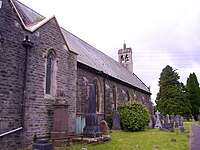Hopkinstown (Welsh: Trehopcyn) is a small village to the west of Pontypridd in the county borough of Rhondda Cynon Taf, Wales, alongside the River Rhondda. Hopkinstown is a former coalmining and industrial community, now a district in the town of Pontypridd within the Rhondda electoral ward. Neighbouring settlements are Pwllgwaun, Trehafod and Pantygraigwen, and the sub-districts of Troed-Rhiw-Trwyn and Gyfeillion.
Hopkinstown
| |
|---|---|
 Saint David's Church, Hopkinstown (closed Feb 2022)[1] | |
Location within Rhondda Cynon Taf | |
| OS grid reference | ST060904 |
| Principal area | |
| Preserved county | |
| Country | Wales |
| Sovereign state | United Kingdom |
| Post town | PONTYPRIDD |
| Postcode district | CF37 |
| Dialling code | 01443 |
| Police | South Wales |
| Fire | South Wales |
| Ambulance | Welsh |
| UK Parliament | |
| Senedd Cymru – Welsh Parliament | |
Early and industrial history edit
The area where Hopkinstown is located was, as late as 1842, an undeveloped woodland known as the Ty Mawr Estate. Owned by Evan Hopkin, the area developed quickly, until around 1850 it was beginning to urbanise after the sinking of two collieries: Ty Mawr and Gyfeillion. Along with buildings to house the miners, Hopkinstown quickly acquired a chemical works, an iron foundry and coke ovens.
The original village was a single row of houses along the Rhondda Road that followed the river. Not until the 1871 census was the name Hopkin's Town used to describe it. By 1891 the village had a population of over 1,500 and several streets of terraced houses had been built.
Hopkinstown saw eight shafts sunk in the industrial period. John Calvert, an engineer from Yorkshire, had already sunk the Newbridge Colliery (later part of the Maritime Collieries, near Graig, Pontypridd), and in 1848 he funded the construction of the Gyfeillon Colliery. It passed to the Great Western Railway company, then reverted to Calvert before he sold it to the Great Western Colliery Company, which sank a total of six shafts known collectively as the Great Western Collieries.
Two other mines in the area, not owned by the Great Western, were the Typica Pit at Troed-rhiw-trwyn, which was only open for five years between 1875 and 1879, and the Lan Colliery, the only pit in Hopkinstown south of the River Rhondda. In 1889 it was owned by William Davies of Pontypridd, employing only seven miners, and was closed in September 1907.[2]
On Tuesday 11 April 1893, fire broke out in the Great Western Mine colliery, trapping some 200 miners underground. Although the majority were rescued, the death-toll was 63 men and boys.[3]
On 23 January 1911 eleven people died in the Hopkinstown rail disaster,[4] when a carriage carrying passengers collided with a stationary coal train on the Taff Vale Railway line.
Notable residents edit
- Elaine Morgan (1920–2013), script-writer, populariser of science and feminist writer, was born in the village.
External links edit
- Rhondda Cynon Taff Library Service Heritage Trail, Hopkinstown
References edit
- ^ "Meet the Team". Pontypridd Ministry Area. Archived from the original on 28 July 2022. Retrieved 28 July 2022.
- ^ Rhondda Collieries, Volume 1, Number 4 in the Coalfield Series; John Cornwell. D.Brown and Sons Ltd, Cowbridge (1987) pg. 8 ISBN 0-905928-82-2
- ^ "The Great Western Colliery, Hopkinstown, Pontypridd". welshcoalmines.co.uk. Retrieved 27 February 2012.
- ^ The Welsh Academy Encyclopaedia of Wales. John Davies, Nigel Jenkins, Menna Baines and Peredur Lynch (2008) pg730 ISBN 978-0-7083-1953-6
